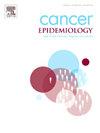加湿器消毒剂的使用与肺癌发展之间的关系:一项嵌套病例队列研究
IF 2.3
3区 医学
Q3 ONCOLOGY
引用次数: 0
摘要
目的通过对加湿器消毒剂(HDs)使用者肺部疾病的暴发,鉴定出加湿器消毒剂相关性肺损伤(HDLI)病例。随后的研究强调了与hd相关的呼吸系统健康风险,但与肺癌的关系仍不确定。目的:评估暴露于高分辨率电子烟人群发生肺癌的风险,探讨高分辨率电子烟暴露对肺癌发生的影响。材料和方法使用国家数据库进行了一项队列研究,包括7343名暴露于hd的索赔人。该研究集中于195例确诊肺癌病例,采用标准化发病率比(SIR)与一般人群进行比较,并使用倾向评分匹配的优势比(OR)进行内部比较。结果该研究发现,与韩国普通人群相比,暴露于hd的个体的肺癌发病率明显更高,男性和女性的SIR均升高(SIR = 3.43, 95 % CI = 2.81-4.13;SIR = 11.19, 95 % CI = 8.95-13.82(女性)。在倾向评分匹配的病例对照设计中,使用hd的持续时间越长,肺癌风险增加(使用hd超过49个月的OR = 2.48, 95 % CI = 1.35-4.56,每一个月的OR = 1.02, 95 % CI = 1.01 - 1.03)。结论:研究结果表明,暴露于HDs与肺癌风险增加之间存在潜在关联。本文章由计算机程序翻译,如有差异,请以英文原文为准。
Association between humidifier disinfectant use and development of lung cancer: A nested case-cohort study
Objective
The outbreak of lung disease among humidifier disinfectants (HDs) users lead to the identification of humidifier disinfectants-associated lung injury (HDLI) cases. Subsequent research highlighted the respiratory health risks associated HDs but the connection to lung cancer remained uncertain. To assess the risk of lung cancer development among individuals exposed to HDs and to investigate the characteristics of HDs exposure influencing the occurrence of lung cancer.
Materials and methods
A cohort study was conducted using the national database, encompassing 7343 claimants exposed to HDs. The study focused on 195 confirmed lung cancer cases, employing the standardized incidence ratio (SIR) for comparisons with the general population, and the odds ratio (OR) using propensity score matching for internal comparisons.
Results
The study found a significantly higher incidence of lung cancer among individuals exposed to HDs compared to the general Korean population, with elevated SIRs observed in both men and women (SIR = 3.43, 95 % CI = 2.81–4.13 for men; SIR = 11.19, 95 % CI = 8.95–13.82 for women). In the propensity score-matched case-control design, a longer duration of HDs use was associated with an increased risk of lung cancer (OR = 2.48, 95 % CI = 1.35–4.56 for using HDs for more than 49 months and OR = 1.02, 95 % CI = 1.01 – 1.03 for every one month).
Conclusion
The findings suggest a potential association between HDs exposure and an increased risk of lung cancer.
求助全文
通过发布文献求助,成功后即可免费获取论文全文。
去求助
来源期刊

Cancer Epidemiology
医学-肿瘤学
CiteScore
4.50
自引率
3.80%
发文量
200
审稿时长
39 days
期刊介绍:
Cancer Epidemiology is dedicated to increasing understanding about cancer causes, prevention and control. The scope of the journal embraces all aspects of cancer epidemiology including:
• Descriptive epidemiology
• Studies of risk factors for disease initiation, development and prognosis
• Screening and early detection
• Prevention and control
• Methodological issues
The journal publishes original research articles (full length and short reports), systematic reviews and meta-analyses, editorials, commentaries and letters to the editor commenting on previously published research.
 求助内容:
求助内容: 应助结果提醒方式:
应助结果提醒方式:


